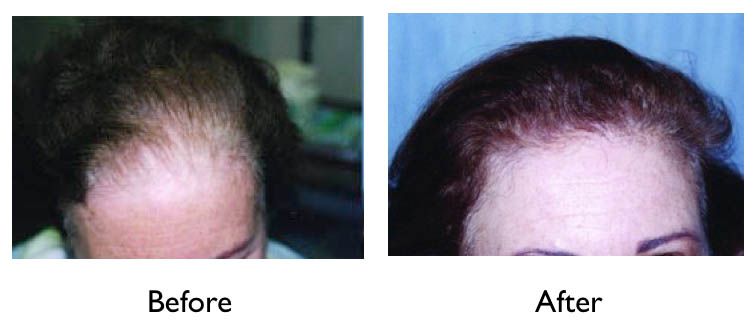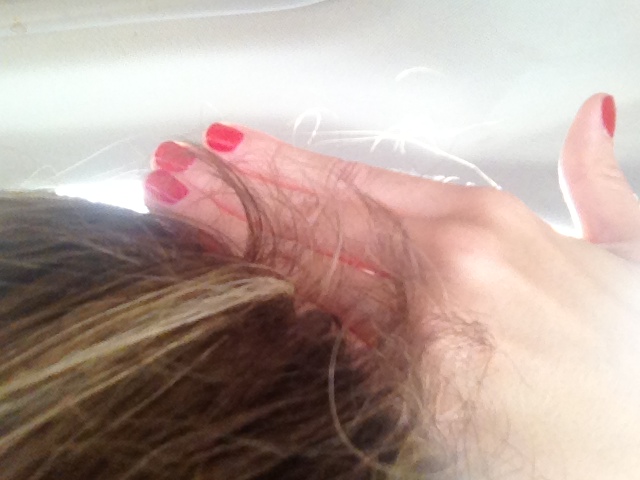Female hair loss occurs in more than one pattern, and often, these patterns are not as easily recognizable as those in men. Hair loss in men is likely to occur primarily between the late teenage years and ages 40-50. This is generally recognizable as male pattern baldness, or medically known as androgenetic alopecia. Men with male pattern baldness may have an expectation of continued hair loss if they have male relatives who have lost their hair in a similar pattern.
Unlike hair loss in men, female hair loss may begin at any age and continue on throughout the age of 50 or later. Female hair loss may not have any obvious hereditary association and may also tend to have less obvious patterns of hair loss than men. In addition to that, a woman who notices the beginning of hair loss will have no way of knowing if the loss is going to be temporary or permanent — for example, a woman may be experiencing hair loss due to circumstances that warrant temporary hair loss, such as pregnancy or illness. Therefore, self-diagnosis is often ineffective and should be made by a trained and experienced physician.
The most likely cause of female hair loss is androgenetic alopecia — an inherited sensitivity to the effects of androgens (male hormones) on scalp hair follicles. However, female hair loss usually does not develop into true baldness in the same patterns that occur in men—for example, women rarely develop the “cue-ball” appearance often seen in male-pattern androgenetic alopecia.
In most cases, however, female hair loss can be effectively treated.

Patterns of Female Hair Loss
Patterns of female hair loss can vary considerably in appearance. These types of patterns may include the following:
- Diffuse thinning of hair over the entire scalp, with more noticeable thinning toward the back of the scalp.
- Diffuse thinning of hair over the entire scalp, with more noticeable thinning toward the front of the scalp, but not involving the frontal hairline.
- Diffuse thinning of hair over the entire scalp, with more noticeable thinning toward the front of the scalp, involving and sometimes breaching the frontal hairline.
Female hair loss due to androgenetic alopecia tend to have miniaturizing hairs of a variable diameter over all affected areas of the scalp. While miniaturizing hairs are a feature of androgenetic alopecia, miniaturization may also be associated with other causes and should not be considered a diagnostic feature of androgenetic alopecia. Post-menopausal women, for example, may begin to experience miniaturization of hair, as well. A precise diagnosis should always be made by a hair restoration specialist.

Non-Pattern Causes of Female Hair Loss
More often than not, women may experience hair loss due to conditions other than androgenetic alopecia. Some of the most common causes are:
- Trichotillomania — compulsive hair pulling. Hair loss due to trichotillomania is typically patchy, as compulsive hair pullers tend to concentrate the pulling in selected areas. Hair loss due to this cause cannot be treated effectively until the psychological or emotional reasons for trichotillomania are effectively addressed.
- Alopecia Areata — a possibly autoimmune disorder that causes patchy hair loss that can range from diffuse thinning to extensive areas of baldness with “islands” of retained hair. Medical examination is necessary to establish a proper diagnosis.
- Triangular Alopecia — loss of hair in the temporal areas that sometimes begins in childhood. Hair loss may be complete, or a few fine, thin-diameter hairs may remain. The cause of triangular alopecia is not known, but the condition can be treated either medically or surgically.
- Scarring Alopecia — hair loss due to scarring of the scalp area. Scarring alopecia typically involves the top of the scalp and occurs predominantly in women. The condition is commonly seen in African-American women and is believed to be associated with persistent tight braiding or “corn-rowing” of scalp hair. A form of scarring alopecia also may occur in post-menopausal women, associated with inflammation of hair follicles and subsequent scarring.
- Telogen Effluvium — a common type of hair loss that is caused when a large percentage of scalp hairs are shifted into “shedding” phase. The causes of telogen effluvium may be hormonal, nutritional, drug-, or stress-related.
- Loose-Anagen Syndrome — a condition occurring primarily in fair-haired persons in which scalp hair sits loosely in hair follicles and is easily extracted by combing or pulling. The condition may appear in childhood, and may improve as the person ages.
For more information about other hair loss causes, please go to Understanding Hair Loss.
Diagnosis and Treatment of Female Hair Loss
If you are a woman experiencing thinning or lost scalp hair, your first necessary step is to have the condition correctly diagnosed by a hair restoration specialist. After a diagnosis is made, the physician will recommend an approach to effective medical or surgical treatment.
Hair Regeneration Treatment
Hair restoration specialist, Dr. Amiya Prasad, M.D., developed the Hair Regeneration treatment in order to address the problem of male and female hair loss. The Hair Regeneration treatment is a non-surgical treatment that makes use of a combination of an extracellular matrix (by ACell), platelet-rich plasma (derived from one’s own blood), and vitamin D, in order to treat and manage hair loss. For more information on this treatment, please visit the Hair Regeneration section.

Photo taken by patient’s cell phone showing growth of “new” hair (reversal of hair thinning) after Hair Regeneration/ACell and PRP treatment.
“My hair was shedding and getting thinner. By the 5th month I noticed sprouts of hair all throughout the part of my hair. This has boosted my confidence more than anything I could have imagined and was one of the best decisions I have ever made”
References
Olsen EA (ed). Female Pattern Hair loss: Clinical Features and Potential Hormonal Factors. J Amer Acad Dermatol 2001; 45:S-70-S80. Olsen EA. Hair disorders. In: Freedberg IM et al (eds.) Fitzpatrick’s Dermatology in General Medicine, 5th ed. New York: McGraw-Hill, 1999:729-751
